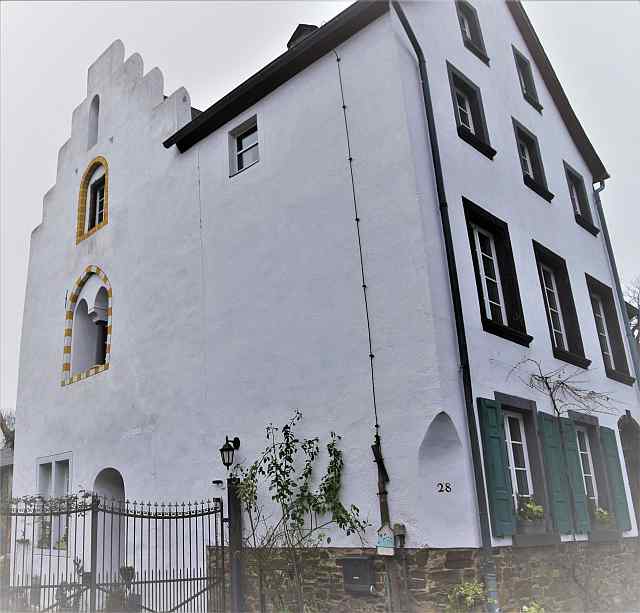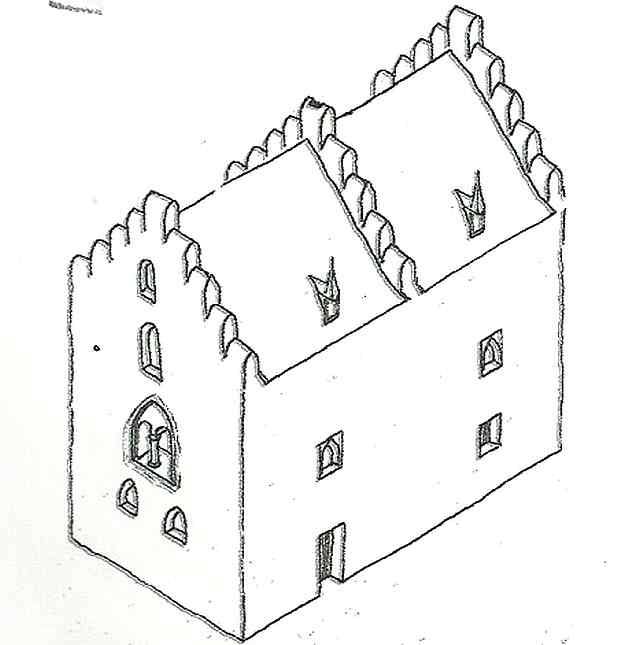4. Gothic House
Built in the 13th century
Semi-detached house neigbouring the
Vicarage of "St. Johannes Evangelist und
St. Catharina". Uncovered and
restored from 2007-2009.
The house was elaborately renovated between 2007-2009. It’s part of a duplex house with gothic crow-stepped gables. The other half is called "Zweierkerhaus” (two-bay house). It’s not known when it was divided and the decision was taken for separate utilisation of the two house halves. In the 18th century, the house was inhabited by the family of an abbey bell ringer. In 1802 it was not part of the secularised abbey estate and remained in private possession.
We are standing in front of the left wing of a semi-detached house, the "Gothic House".

The right wing is known as the "Zweierkerhaus" because of the extension.


It is not known when the semi-detached house was divided. According to a coat-of-arms find, the "Kellner" Georg Broy is assumed to have lived in the Gothic house we are standing in front of in 1600. After 1694, the family of the bell-ringer Johann Pulcher lived in this part of the house.
The collegiate bell-ringer Pulcher belonged to the numerous auxiliary personnel of the monastery for church services and administration. There were 28 different positions.
The prerequisites for serving as a bell ringer - there were two of each - were marital birth, citizenship and firmness in faith. Payment was in kind, and from 1694 also in money. The statutes of the 16th-18th centuries contain, among other things, the following references to the work of the bell-ringers. They were to perform the service personally and not be represented by unreliable boys and girls. They were assigned a place to sleep in the bell tower. During the service they had to ensure silence in the church. They had to pay special attention to the pupils, who often disturbed the devotion of the priests and the faithful by chattering. They also had to take care of the cleanliness of the church. This included removing dog droppings from the church. They had duties in preparing and accompanying the church service. For example, they had to decorate the altars for mass and serve the priest in distributing communion.
The chapter's repeated complaints about neglect of duty make it clear that the bell-ringers were quite difficult servants. Apparently they also had some experience of industrial action. In 1715, after the death of Archbishop Johann Hugo von Orsbeck, they were ordered to ring for one hour every morning and noon for six weeks. They refused and succeeded. When the citizens were then to be obliged to ring the bell, the archbishop's death was not accompanied by bells.
Glossary
"Kellner"
He was responsible for the administration of monetary and in-kind duties to the sovereign.
Johann Hugo von Orsbeck
During his reign (1676-1711), Münstermaifeld, like the entire archbishopric, had to suffer from three wars in succession after the devastation of the Thirty Years' War. These were the final phase of the French-Dutch War, waged by the French King Louis XIV against the Netherlands until 1678, the Palatinate War of Succession from 1688 to 1697, which is considered one of the worst wars of the time, and the Spanish War of Succession, which lasted from 1701 to 1714. In these wars, the citizenry was severely damaged by troop passage, quartering and tribute. The town lost almost all of its old buildings in the fire raids of 1689 and 1691.



